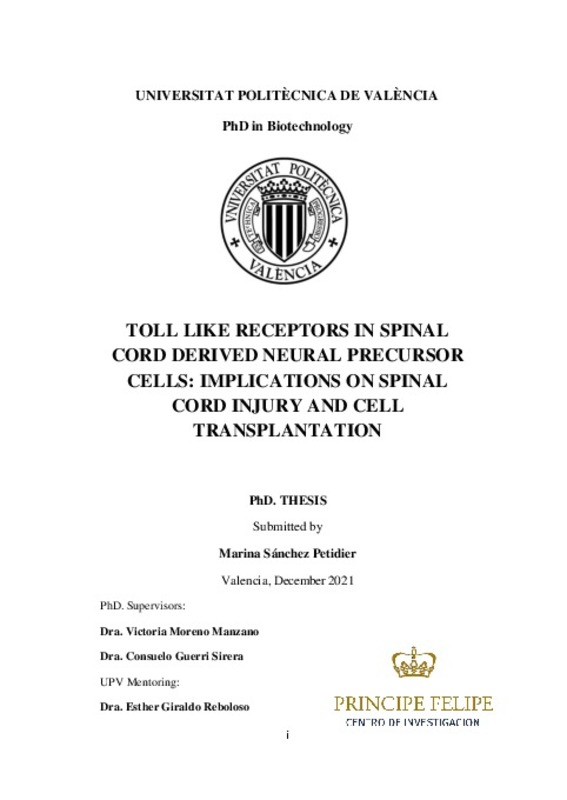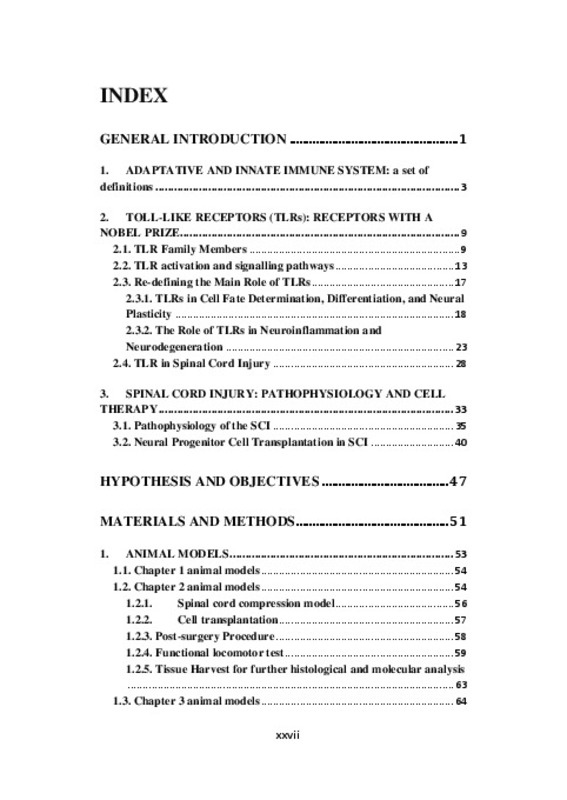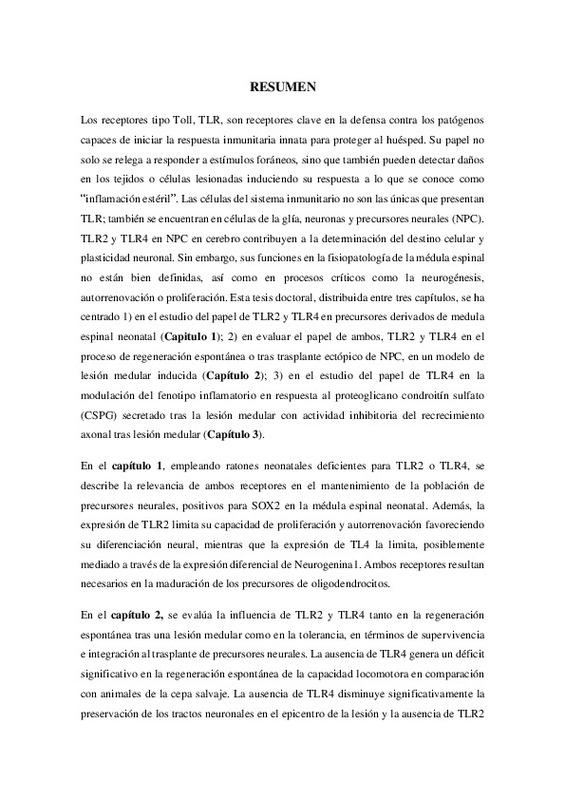- RiuNet repositorio UPV
- :
- Investigación
- :
- Tesis doctorales
- :
- Ver ítem
JavaScript is disabled for your browser. Some features of this site may not work without it.
Buscar en RiuNet
Listar
Mi cuenta
Estadísticas
Ayuda RiuNet
Admin. UPV
Toll-like receptors in spinal cord derived neural precursor cells: implications on spinal cord injury and cell transplantation
Mostrar el registro sencillo del ítem
Ficheros en el ítem
| dc.contributor.advisor | Guerri Sirera, Consuelo
|
es_ES |
| dc.contributor.advisor | Moreno Manzano, Maria Victoria
|
es_ES |
| dc.contributor.author | Sánchez Petidier, Marina
|
es_ES |
| dc.date.accessioned | 2022-02-11T10:13:46Z | |
| dc.date.available | 2022-02-11T10:13:46Z | |
| dc.date.created | 2022-01-11 | |
| dc.date.issued | 2022-02-11 | es_ES |
| dc.identifier.uri | http://hdl.handle.net/10251/180753 | |
| dc.description.abstract | [ES] Los receptores tipo Toll, TLR, son receptores clave en la defensa contra los patógenos capaces de iniciar la respuesta inmunitaria innata para proteger al huésped. Su papel no solo se relega a responder a estímulos foráneos, sino que también pueden detectar daños en los tejidos o células lesionadas induciendo su respuesta a lo que se conoce como "inflamación estéril". Las células del sistema inmunitario no son las únicas que presentan TLR; también se encuentran en células de la glía, neuronas y precursores neurales (NPC). Concretamente, TLR2 y TLR4 en NPC en cerebro contribuyen a la determinación del destino celular y plasticidad neuronal durante el desarrollo. Sin embargo, sus funciones en la fisiología y patología de la médula espinal no están bien definidas, así como en procesos críticos como la neurogénesis, autorrenovación o proliferación. Esta tesis doctoral, distribuida entre tres capítulos, se ha centrado 1) en el estudio del papel de TLR2 y TLR4 en precursores derivados de medula espinal neonatal (Capítulo 1); 2) en evaluar el papel de ambos, TLR2 y TLR4 en el proceso de regeneración espontánea o tras trasplante ectópico de NPC, en un modelo de lesión medular inducida (Capítulo 2); 3) en el estudio del papel de TLR4 en la modulación del fenotipo inflamatorio en respuesta al proteoglicano condroitín sulfato (CSPG) secretado tras la lesión medular con actividad inhibitoria del recrecimiento axonal tras lesión medular (Capítulo 3). | es_ES |
| dc.description.abstract | [CA] Els receptors tipus Toll, TLR, són receptors clau en la defensa contra els patògens capaços d'iniciar la resposta immunitària innata per a protegir l'hoste. El seu paper no sols es relega a respondre a estímuls forans, sinó que també poden detectar danys en els teixits o cèl·lules lesionades induint la seua resposta al que es coneix com a "inflamació estèril". Les cèl·lules del sistema immunitari no són les úniques que presenten TLR; també es troben en cèl·lules de la glia, neurones i precursors neurals (NPC). TLR2 i TLR4 en NPC en cervell contribueixen a la determinació del destí cel·lular i plasticitat neuronal. No obstant això, les seues funcions en la fisiopatologia de la medul·la espinal no estan ben definides, així com en processos crítics com la neurogènesi, autorenovació o proliferació. Aquesta tesi doctoral, distribuïda entre tres capítols, s'ha centrat: 1) En l'estudi del paper de TLR2 i TLR4 en precursors derivats de medul·la espinal neonatal (Capítol 1); 2) A avaluar el paper de tots dos, TLR2 i TLR4, en el procés de regeneració espontània o després de trasplantament ectòpic de NPC, en un model de lesió medul·lar induïda (Capítol 2); 3) En l'estudi del paper de TLR4 en la modulació del fenotip inflamatori en resposta al proteoglicà condroití sulfat (CSPG) secretat després de la lesió medul·lar amb activitat inhibitòria del recreixement axonal després de lesió medul·lar (Capítol 3). | es_ES |
| dc.description.abstract | [EN] Toll-like receptors, TLRs, are key receptors in the defence against pathogens capable of initiating the innate immune response to protect the host. Their role is not only limited to responding to foreign stimuli, but they can also detect damage to injured tissues or cells, inducing their response to what is known as 'sterile inflammation'. Immune system cells are not the only cells that display TLRs; they are also found in glial cells, neurons and neural precursors cells (NPCs). TLR2 and TLR4 NPCs from brain contribute to cell fate determination and neuronal plasticity. However, their roles in spinal cord pathophysiology and in critical processes such as neurogenesis, self-renewal or proliferation are not well defined. This doctoral thesis, distributed among three chapters, has focused: 1) on the study of the role of TLR2 and TLR4 in neonatal spinal cord-derived precursors (Chapter 1); 2) on evaluating the role of both TLR2 and TLR4 in the process of spontaneous regeneration or after ectopic transplantation of NPC, in a model of induced spinal cord injury (Chapter 2); 3) to study the role of TLR4 in modulating the inflammatory phenotype in response to chondroitin sulphate proteoglycan (CSPG) secreted after spinal cord injury with inhibitory activity on axonal regrowth after spinal cord injury (Chapter 3). | es_ES |
| dc.description.sponsorship | The student has been granted with a PhD fellowship from a predoctoral program at the CIPF and with International Research and Training Exchange Programme at the CIPF. This work has been supported by the Spanish Ministry of Economy and Competitiveness (projects RTI2018-095872-B-C21; MAT2015-66666-C3-R; SAF2015-69187R) and Spanish Ministry of Heath, PNSD2018 I003. | es_ES |
| dc.format.extent | 275 | es_ES |
| dc.language | Inglés | es_ES |
| dc.publisher | Universitat Politècnica de València | es_ES |
| dc.rights | Reserva de todos los derechos | es_ES |
| dc.subject | Precursores neurales (NPC) | es_ES |
| dc.subject | Neuroinflamación | es_ES |
| dc.subject | Receptor tipo Toll | es_ES |
| dc.subject | Lesión medular | es_ES |
| dc.subject | Trasplante celular | es_ES |
| dc.subject | Neural precursor cells | es_ES |
| dc.subject | Cell transplantation | es_ES |
| dc.subject | Spinal cord injury | es_ES |
| dc.subject | Toll-like receptor | es_ES |
| dc.subject | Neuroinflammation | es_ES |
| dc.title | Toll-like receptors in spinal cord derived neural precursor cells: implications on spinal cord injury and cell transplantation | es_ES |
| dc.type | Tesis doctoral | es_ES |
| dc.identifier.doi | 10.4995/Thesis/10251/180753 | es_ES |
| dc.relation.projectID | info:eu-repo/grantAgreement/MSC//PNSD-2018-I003/ES/ | es_ES |
| dc.relation.projectID | info:eu-repo/grantAgreement/MINECO//SAF2015-69187-R/ES/MICRORNAS COMO BIOMARCADORES EN LA NEUROINFLAMACION ASOCIADA AL ABUSO DE ALCOHOL: IMPLICACIONES DIAGNOSTICAS Y TERAPEUTICAS/ | es_ES |
| dc.relation.projectID | info:eu-repo/grantAgreement/MINECO//MAT2015-66666-C3-1-R/ES/BIOHIBRIDOS PARA LA PROMOCION DEL CRECIMIENTO AXONAL Y LA REGENERACION EN EL SISTEMA NERVIOSO CENTRAL Y PERIFERICO/ | es_ES |
| dc.relation.projectID | info:eu-repo/grantAgreement/AEI/Plan Estatal de Investigación Científica y Técnica y de Innovación 2017-2020/RTI2018-095872-B-C21/ES/NUEVO BIOMATERIAL BIO-ACTIVO PARA LA REGENERACION DE LESIONES MEDULARES/ | es_ES |
| dc.rights.accessRights | Abierto | es_ES |
| dc.contributor.affiliation | Universitat Politècnica de València. Departamento de Biotecnología - Departament de Biotecnologia | es_ES |
| dc.description.bibliographicCitation | Sánchez Petidier, M. (2022). Toll-like receptors in spinal cord derived neural precursor cells: implications on spinal cord injury and cell transplantation [Tesis doctoral]. Universitat Politècnica de València. https://doi.org/10.4995/Thesis/10251/180753 | es_ES |
| dc.description.accrualMethod | TESIS | es_ES |
| dc.type.version | info:eu-repo/semantics/acceptedVersion | es_ES |
| dc.relation.pasarela | TESIS\12036 | es_ES |
| dc.contributor.funder | Ministerio de Sanidad y Consumo | es_ES |
| dc.contributor.funder | Centro de Investigación Príncipe Felipe | es_ES |
| dc.contributor.funder | Ministerio de Economía y Competitividad | es_ES |
| dc.contributor.funder | Agencia Estatal de Investigación | es_ES |
Este ítem aparece en la(s) siguiente(s) colección(ones)
-
Tesis doctorales [5389]










